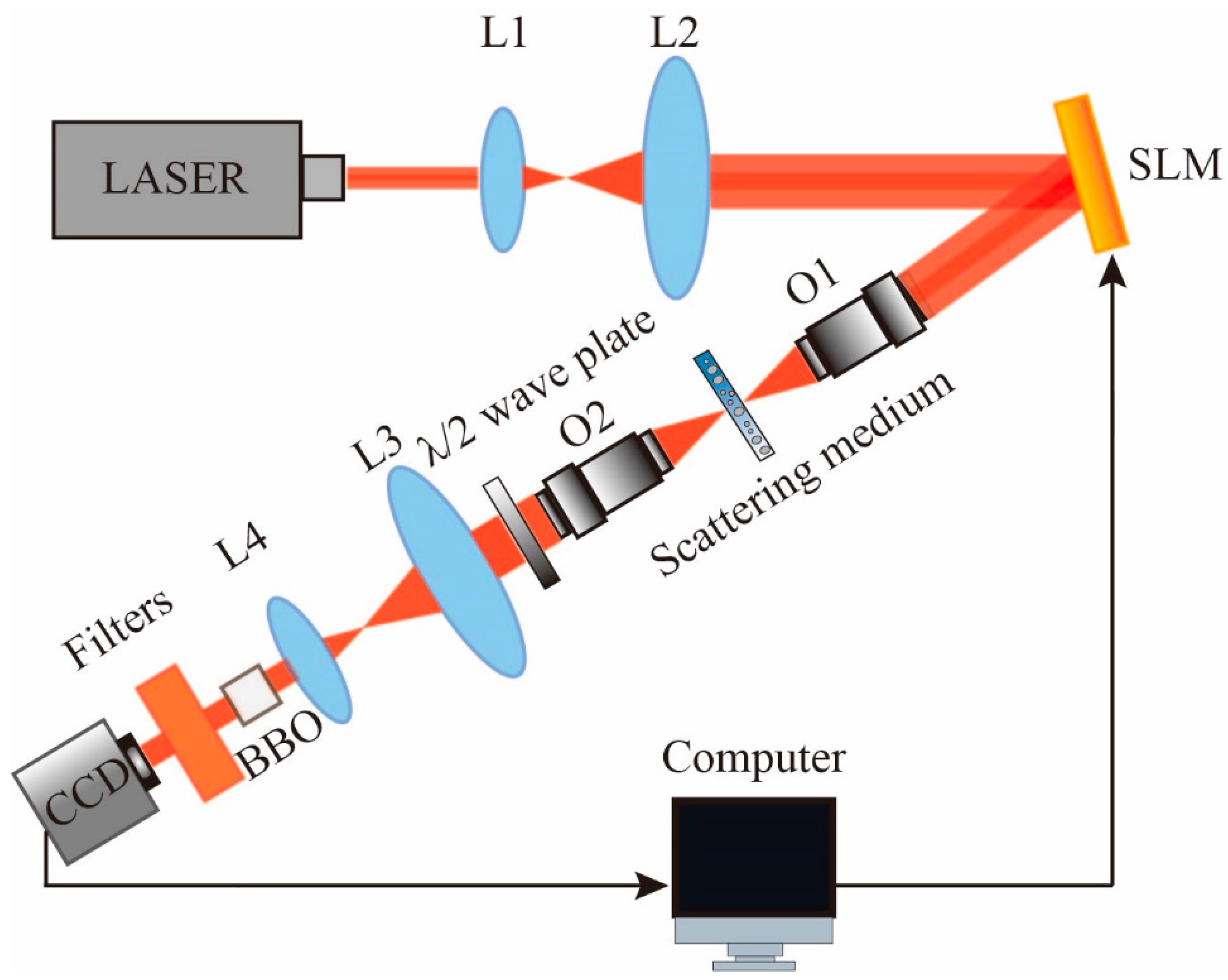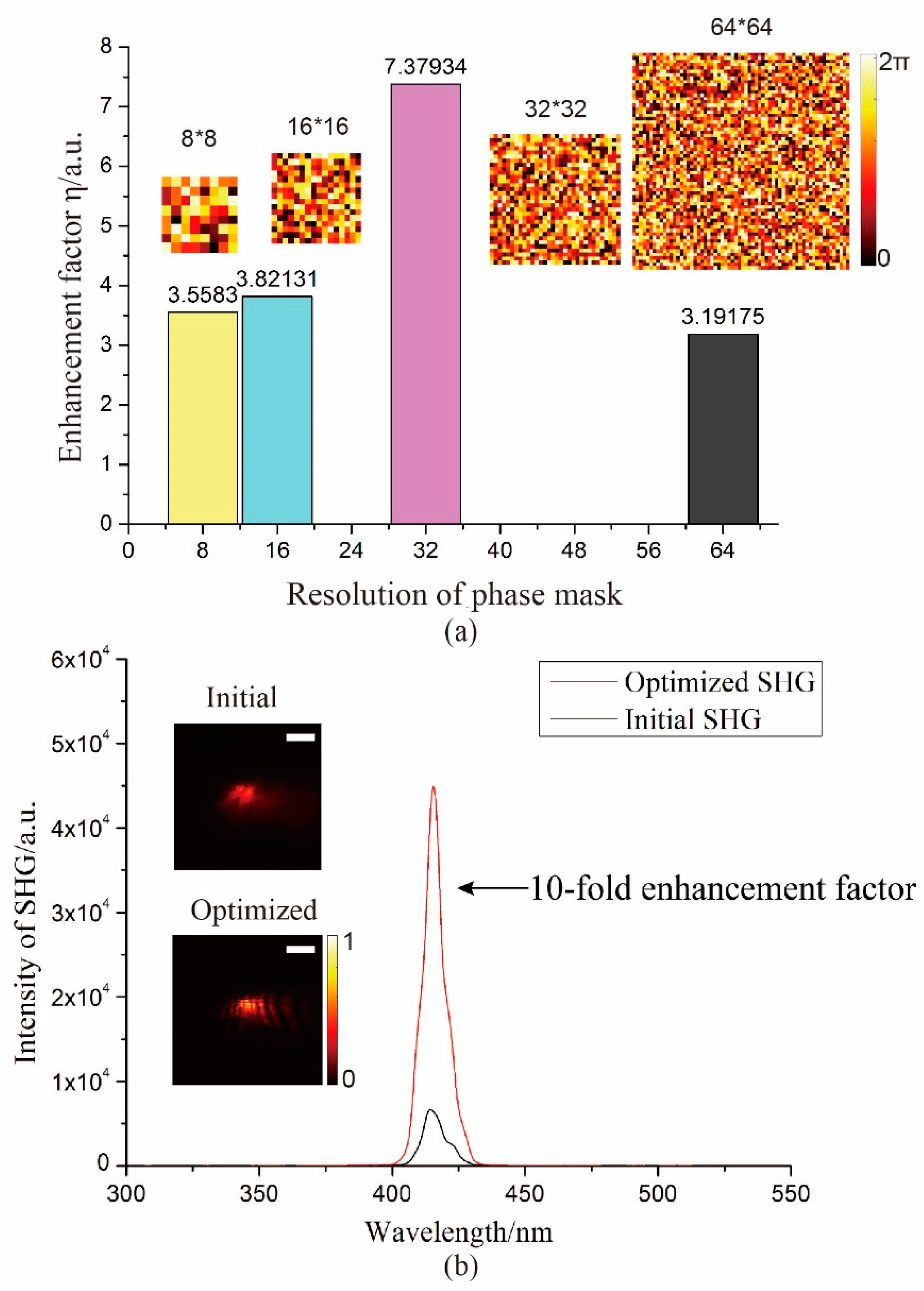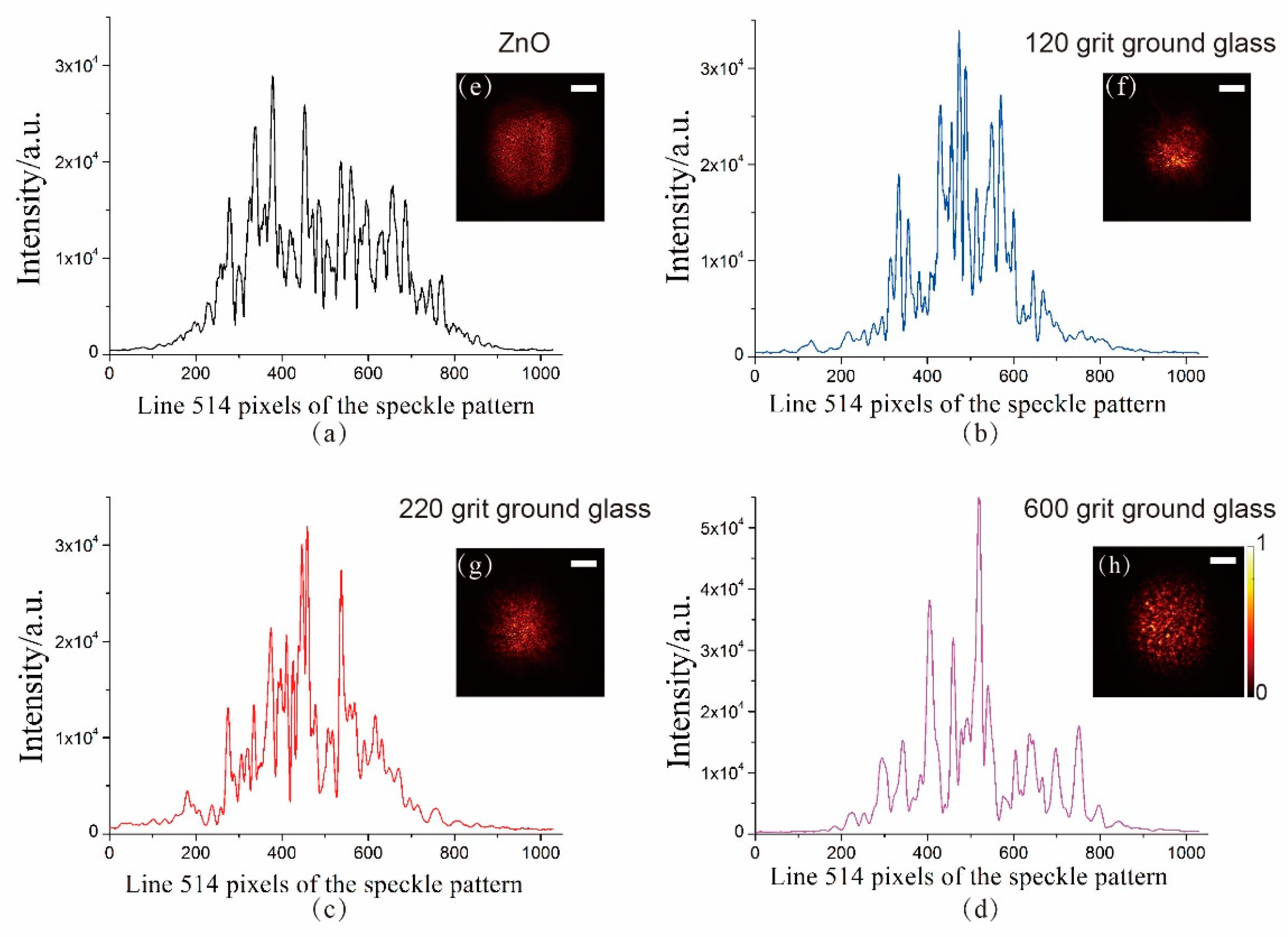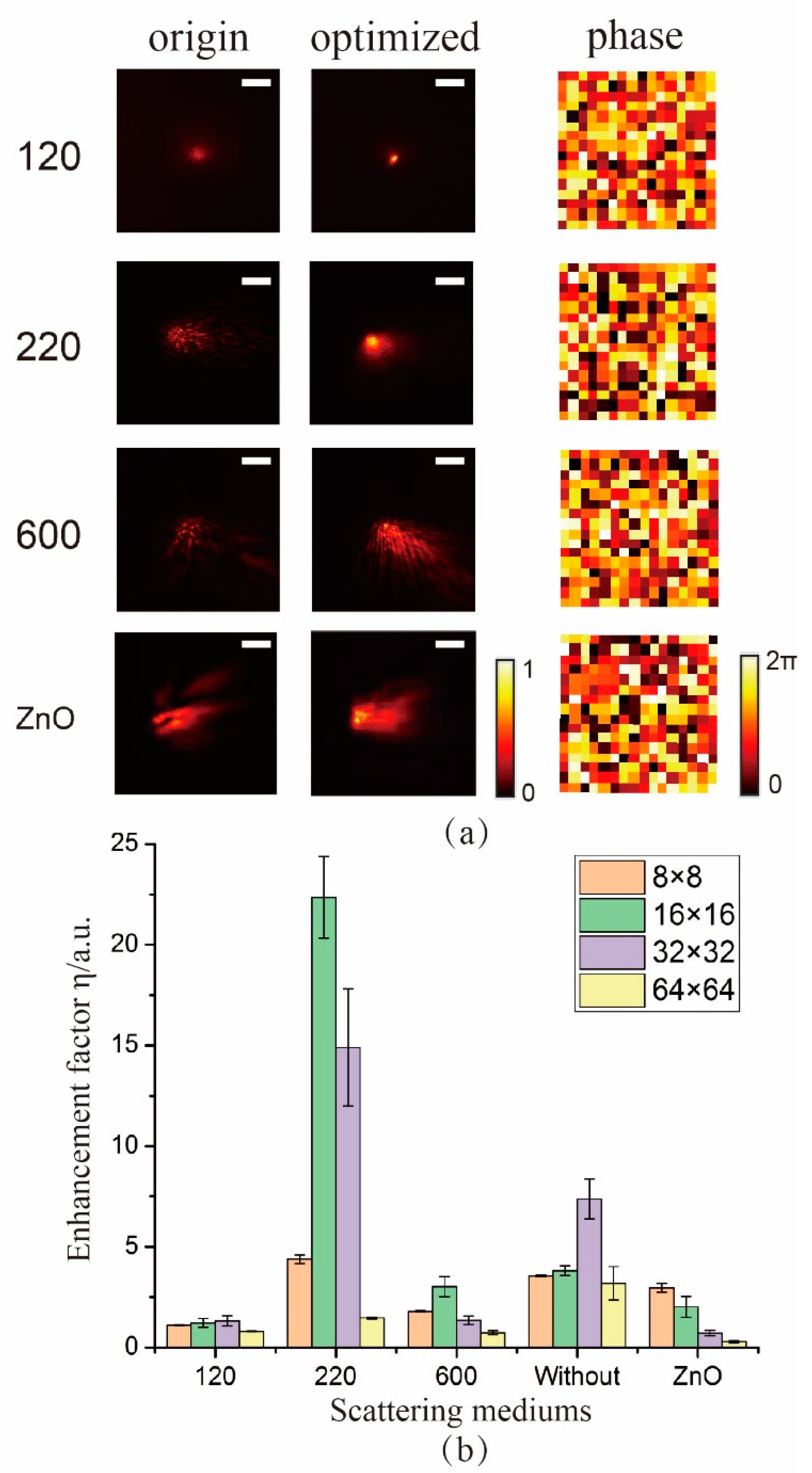Efficient Enhancement of Second Harmonic Generation via Noninvasive Modulation
Abstract
:1. Introduction
2. Methods and Experimental Setup
2.1. Methods
2.2. Experimental Setup
3. Results and Discussion
3.1. Enhancement of SHG without Scattering Effect
3.2. Different Scattering Mediums
3.3. Enhancement of SHG with Scattering Effect
4. Conclusions
Author Contributions
Funding
Institutional Review Board Statement
Data Availability Statement
Conflicts of Interest
References
- Franken, P.A.; Hill, A.E.; Peters, C.W.; Weinreich, G. Generation of optical harmonics. Phys. Rev. Lett. 1961, 7, 118–119. [Google Scholar] [CrossRef] [Green Version]
- Chen, X.Y.; Nadiarynkh, O.; Plotnikov, S.; Campagnola, P.J. Second harmonic generation microscopy for quantitative analysis of collagen fibrillar structure. Nat. Protoc. 2012, 7, 654–669. [Google Scholar] [CrossRef] [PubMed]
- Campagnola, P.J.; Dong, C.Y. Second harmonic generation microscopy: Principles and applications to disease diagnosis. Laser Photon. Rev. 2011, 5, 13–26. [Google Scholar] [CrossRef]
- Keikhosravi, A.; Bredfeldt, J.S.; Sagar, A.K.; Eliceiri, K.W. Second-harmonic generation imaging of cancer. Method Cell Biol. 2014, 123, 531–546. [Google Scholar]
- Wang, C.; Zhang, M.; Yu, M.; Zhu, R.; Hu, H.; Loncar, M. Monolithic lithium niobate photonic circuits for Kerr frequency comb generation and modulation. Nat. Commun. 2019, 10, 233–237. [Google Scholar] [CrossRef] [PubMed]
- Andrea, G.; Gorazd, P.; Daniele, R.; Degl′Innocenti, R.; Gunter, P. Electro–optically tunable microring resonators in lithium niobate. Nature. Photon. 2007, 1, 407–410. [Google Scholar]
- Abdelmonem, A.; Lützenkirchen, J.; Leisner, T. Probing ice-nucleation processes on the molecular level using second harmonic generation spectroscopy. Atmos. Meas. Tech. 2015, 8, 3519–3526. [Google Scholar] [CrossRef] [Green Version]
- Shen, Y.R. Surface properties probed by second-harmonic and sum-frequency generation. Nature 1989, 337, 519–525. [Google Scholar] [CrossRef] [Green Version]
- Takahashi, H.; Miyauchi, Y.; Mizutani, G. Selective observation of local carrier dynamics at step bunches on vicinal TiO2 (110) by time-resolved pump-probe second harmonic generation method. Phy. Rev. B. 2012, 86, 045447. [Google Scholar] [CrossRef]
- Sun, Z.; Yi, Y.; Song, T. Giant nonreciprocal second-harmonic generation from antiferromagnetic bilayer CrI3. Nature 2019, 572, 497–501. [Google Scholar] [CrossRef]
- Boyd, R.W. Nonlinear Optics; Academic Press: Cambridge, MA, USA, 2008. [Google Scholar]
- Padma, N.J.; Dhruba, J.B. Exploitation of an external unstable multi-pass cavity to enhance the second harmonic conversion efficiency. Opt. Commun. 2015, 341, 155–159. [Google Scholar] [CrossRef]
- Thompson, J.V.; Hokr, B.H.; Throckmorton, G.A.; Wang, D.W.; Scully, M.O.; Yakovlev, V.V. Enhanced second harmonic generation efficiency via wavefront shaping. ACS Photonics 2017, 4, 1790–1796. [Google Scholar] [CrossRef]
- Fan, W.R.; Chen, T.R.; Gil, E.; Zhu, S.Y.; Wang, D.W. Second harmonic imaging enhanced by deep learning decipher. ACS Photonics. 2021, 8, 1562–1568. [Google Scholar] [CrossRef]
- Nikolaev, N.A.; Yu, M.A.; Antsygin, V.D.; Bekker, T.B.; Ezhov, D.M.; Kokh, A.E.; Kokh, K.A.; Lanskii, G.V.; Mamrashev, A.A.; Svetlichnyi, V.A. Optical properties of β-BBO and potential for THz applications. J. Phys. Conf. Ser. 2018, 951, 012003. [Google Scholar] [CrossRef]
- Nguyen, D.T.T.; Lai, N.D. Deterministic Insertion of KTP Nanoparticles into Polymeric Structures for Efficient Second-Harmonic Generation. Crystals 2019, 9, 365. [Google Scholar] [CrossRef] [Green Version]
- Wei, D.; Wang, C.; Wang, H.; Hu, X.; Wei, D.; Fang, X.; Zhang, Y.; Wu, D.; Hu, Y.; Li, J.; et al. Experimental demonstration of a three-dimensional lithium niobate nonlinear photonic crystal. Nat. Photon. 2018, 12, 596–600. [Google Scholar] [CrossRef]
- Reintjes, J.; Eckardt, R.C. Efficient harmonic generation from 532 to 266 nm in ADP and KD*P. Appl. Phys. Lett. 1977, 30, 91–93. [Google Scholar] [CrossRef]
- Chen, B.Q.; Ren, M.L.; Liu, R.J.; Zhang, C.; Sheng, Y.; Ma, B.; Li, Z. Simultaneous broadband generation of second and third harmonics from chirped nonlinear photonic crystals. Light Sci. Appl. 2014, 3, 189. [Google Scholar] [CrossRef]
- Lightman, S.; Gvishi, R.; Hurvitz, G.; Arie, A. Shaping of light beams by 3D direct laser writing on facets of nonlinear crystals. Opt. Lett. 2015, 40, 4460. [Google Scholar] [CrossRef]
- Shapira, A.; Libster, A.; Lilach, Y.; Arie, A. Functional facets for nonlinear crystals. Opt. Commun. 2013, 300, 244–248. [Google Scholar] [CrossRef]
- Liu, H.G.; Chen, X.F. The manipulation of second-order nonlinear harmonic wave by structured material and structured light. J. Nonlinear Opt. Phys. 2018, 27, 21. [Google Scholar] [CrossRef]
- Heinze, J.; Vahlbruch, H.; Willke, B. Frequency-doubling of continuous laser light in Laguerre-Gaussian modes LG(0,0) and LG(3,3). Opt. Lett. 2020, 45, 52–62. [Google Scholar]
- Wang, J.; Clementi, M.; Minkov, M.; Barone, A.; Carlin, J.-F.; Grandjean, N.; Gerace, D.; Fan, S.; Galli, M.; Houdré, R. Doubly resonant second-harmonic generation of a vortex beam from a bound state in the continuum. Optica 2020, 7, 1126–1132. [Google Scholar] [CrossRef]
- Zhang, L.; Qiu, X.; Li, F. Second harmonic generation with full Poincaré beams. Opt. Express. 2018, 26, 11678–11684. [Google Scholar] [CrossRef] [Green Version]
- Vellekoop, I.M. Feedback-based wavefront shaping. Opt. Express 2015, 23, 12189–12206. [Google Scholar] [CrossRef]
- Brown, E.; McKee, T.; DiTomaso, E.; Pluen, A.; Seed, B.; Boucher, Y.; Jain, R.K. Dynamic imaging of collagen and its modulation in tumors in vivo using second-harmonic generation. Nat. Med. 2003, 9, 796–800. [Google Scholar] [CrossRef]
- Vellekoop, I.M.; Mosk, A.P. Focusing coherent light through opaque strongly scattering media. Opt. Lett. 2007, 32, 2309–2311. [Google Scholar] [CrossRef]
- Sheng, S.C.; Siegman, A.E. Nonlinear-optical calculations using fast-transform methods: Second-harmonic generation with depletion and diffraction. Phys. Rev. A 1980, 21, 599–606. [Google Scholar] [CrossRef]
- Qiao, Y.; Peng, Y.; Zheng, Y. Second-harmonic focusing by a nonlinear turbid medium via feedback-based wavefront shaping. Opt. Lett. 2017, 42, 1895–1898. [Google Scholar] [CrossRef] [Green Version]
- Wan, L.P.; Chen, Z.Y.; Huang, H.L.; Pu, J.X. Focusing light into desired patterns through turbid media by feedback-based wavefront shaping. Appl. Phys. B 2016, 122, 204. [Google Scholar] [CrossRef]
- Small, E.; Katz, O.; Guan, Y.; Silberberg, Y. Spectral control of broad-band light through random media by wavefront shaping. Opt. Lett. 2012, 37, 3429–3431. [Google Scholar] [CrossRef] [PubMed] [Green Version]
- Conkey, D.B.; Brown, A.N.; Caravaca-Aguirre, A.M.; Piestun, R. Genetic algorithm optimization for focusing through turbid media in noisy environments. Opt. Express 2012, 20, 4840–4849. [Google Scholar] [CrossRef] [PubMed]




Publisher’s Note: MDPI stays neutral with regard to jurisdictional claims in published maps and institutional affiliations. |
© 2022 by the authors. Licensee MDPI, Basel, Switzerland. This article is an open access article distributed under the terms and conditions of the Creative Commons Attribution (CC BY) license (https://creativecommons.org/licenses/by/4.0/).
Share and Cite
Wu, L.; Fan, W.; Chen, Z.; Pu, J. Efficient Enhancement of Second Harmonic Generation via Noninvasive Modulation. Appl. Sci. 2022, 12, 3962. https://doi.org/10.3390/app12083962
Wu L, Fan W, Chen Z, Pu J. Efficient Enhancement of Second Harmonic Generation via Noninvasive Modulation. Applied Sciences. 2022; 12(8):3962. https://doi.org/10.3390/app12083962
Chicago/Turabian StyleWu, Liqing, Weiru Fan, Ziyang Chen, and Jixiong Pu. 2022. "Efficient Enhancement of Second Harmonic Generation via Noninvasive Modulation" Applied Sciences 12, no. 8: 3962. https://doi.org/10.3390/app12083962
APA StyleWu, L., Fan, W., Chen, Z., & Pu, J. (2022). Efficient Enhancement of Second Harmonic Generation via Noninvasive Modulation. Applied Sciences, 12(8), 3962. https://doi.org/10.3390/app12083962






